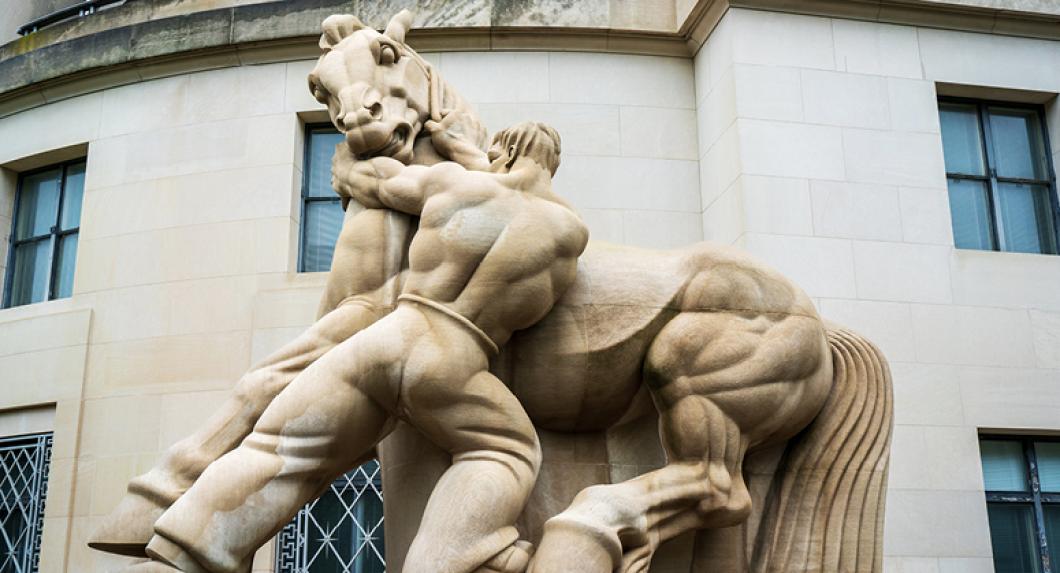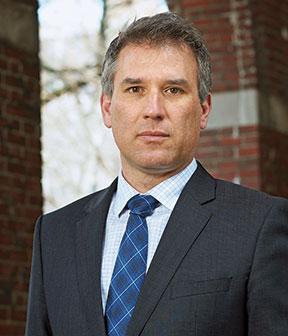On May 15, Assistant Professor Daniel Francis JSD ’20 and Murray and Kathleen Bring Professor of Law Christopher Jon Sprigman published Antitrust: Principles, Cases, and Materials, a new openly licensed textbook available for free download. Created with support from the American Bar Association’s (ABA) Antitrust Law Section, the book continues a tradition of openly licensed textbooks by NYU Law faculty that includes John M. Desmarais Professor of Intellectual Property Law Barton Beebe’s trademark law casebook as well as Walter J. Derenberg Professor of Intellectual Property Law Jeanne Fromer and Sprigman’s copyright law textbook.
The success of the copyright casebook, which is used in roughly six dozen US law schools, prompted Jonathan Gleklen, then chair of the ABA’s antitrust section, to reach out to Sprigman in 2021. Gleklen envisioned an openly licensed textbook for antitrust, and he hoped Sprigman would co-author it. Gleklen also recruited Francis, who had completed his JSD at NYU Law the previous year and who would become Sprigman’s faculty colleague in 2022. When Sprigman and Francis set up an initial online meeting in summer 2021, they realized they had similar ideas about the project.
“Daniel and I tried to air the full range of modern views about antitrust and its role in our economy and society,” says Sprigman. “This is a great time to write an antitrust book, because the debate around competition issues is livelier today than it has been in many decades.”
“The rate of change in antitrust is dramatic,” Francis says. “[There are] new agency positions, blockbuster decisions coming out of the courts, new policy statements, new scholarly contributions offering really different or challenging perspectives on antitrust…. To the extent that the antitrust conversation continues to be a vibrant and perhaps volatile one, having this very nimble digital model where we have seamless annual updates is going to mean students and teachers always have in their hands a volume that is bang up to date.”
Sprigman and Francis also wanted to address the need for greater diversity and inclusion in the antitrust field, and lowering the economic barrier-to-entry for law students interested in studying antitrust seemed like a logical place to start. The online text is completely free, and a print-on-demand copy costs less than $17.
Since not all law student have an economics background, the co-authors included an easily digestible chapter summarizing antitrust economics.
One notion they wanted to convey, Sprigman adds, is that antitrust is “an extremely socially important field with a diversity of views, some of which get to deep questions [such as] what purposes does capitalism serve, and how well do markets work in providing social welfare and fair distribution…. We’ve tried to present these in a way that is not particularly judgmental and attempts to give a charitable reading to the different ways of thinking about these various issues.”
The book benefited greatly, both co-authors say, from the extensive input of Professor Douglas Ross of the University of Washington School of Law, whom Francis describes as “a giant of the antitrust bar.” Ross offered his thoughts on his experience teaching from other antitrust books as well as the book’s design, tone, and content structure. He also allowed his class to use the book in the pilot stage, along with several other classes, including Sprigman’s and Francis’s, whose feedback helped the co-authors improve the content.
Antitrust: Principles, Cases, and Materials is the end product of a two-year collaboration that both co-authors found rewarding. “I think we have compatible writing styles, and it was a delightful process,” says Sprigman. “A lot of work but also a lot of fun.”
“Doing this with Chris over the last two years has been a joy,” Francis adds. “The fact that we had not only that great experience but also something to share with the world at the end of it has been a wonderful way to celebrate my first year of being here at NYU.”
The book’s cover features a striking pair of photographs taken by Taylor Owings, Francis’s wife. They show Man Controlling Trade, monumental twin statues on either side of the Federal Trade Commission Building in Washington, DC, that each depict a man bridling a horse differently—illustrating, Francis says, “the ambiguity of the relationship between trade and freedom, restraint and power, and what it means to have a free market and the forms of coercion that are implicit in it.”
The sculptures make concrete the idea that “we’re harnessing the animal spirits of the economy, partly through antitrust, which aims to keep markets open and contestable,” Sprigman adds. “Antitrust always was attractive to me because of its deep social implications. It really is a set of choices about how we live, about how we organize our economic life, which spills over into everything else.”
Posted July 17, 2023


